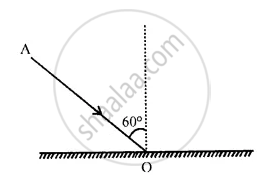Advertisements
Advertisements
Question
Draw a neat two ray diagram for the formation of images in two plane mirrors, when mirrors are at facing each other.
Solution
When two mirrors are parallel to each other

Consider two plane mirrors XY and PQ facing each other and ‘A’ as an object situated anywhere between them (See figure).
It is clear that mirror XY forms its image in mirror PQ and vice versa. These images by themsleves will act as image mirror or virtual mirrors.
Let us consider the normal incidence towards the mirror XY for object A. First of all an image X1 is formed as far behind, as the object is in front of it. This image X1 will fall in front of mirror PQ, and hence, forms an image X2. The image X2 falls in front of mirror XY and hence, forms an image X3. Thus, it continues and infinite images can be formed.
Similarly, taking normal incidence for mirror PQ image P1,P2, P3 etc. are formed.
In order to draw ray diagram, from point A, draw a divergent beam, meeting mirror PQ at points 1 and 2. With P1 as a reference point, draw rays 1, 3, and 2, 4 meeting mirror XY. With P3 as reference point draw rays, such that they enter the eye.
APPEARS IN
RELATED QUESTIONS
Write true or false of the following statement.
When a light ray is reflected from a wall, the angle of incidence is not equal to the angle of reflection.
The diagram in fig. shows an incident ray AO and the normal ON on a plane mirror. Draw the reflected ray. State the law you use to draw the direction of the reflected ray.

Why is it difficult to read the image of the text of a page formed due to reflection by a plane mirror?
The image formed by a plane mirror is :
A man standing in front of a plane mirror finds his image at a distance 6 metre from himself. What is the distance of man from the mirror?
An insect is sitting in front of a plane mirror at a distance 1 m from it.
(b) What is the distance between the insect and its image?
Explain the following term:
Normal Draw
diagram/diagrams to show them.
Parallel rays are incident:
- on regular surface and
- on irregular surface. In what respect do reflected rays in (1) differ from those of (2)?
